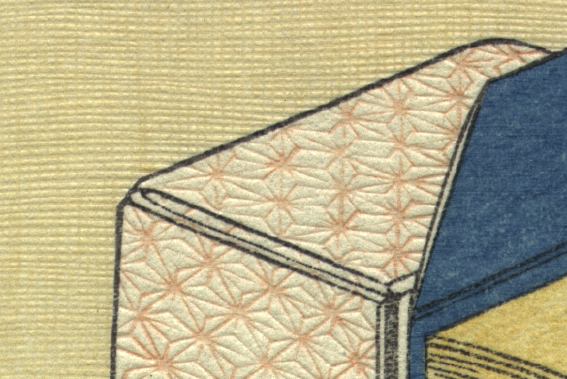Embossing
Types of Embossing
Embossing is one of the techniques that sets woodblock printmaking apart from many other types of printmaking. It is the one that most dramatically announces to the viewer that 'this print is a relief print!'
It was a common technique back in the Edo-era, being used in many types of prints, but it came into its own in the genre known as 'surimono' - those 'deluxe' prints made for private circulation among members of poetry groups. The paper used for these prints was particularly thick and 'fluffy', and embossing showed to great effect.

There are two related Japanese techniques that are grouped together with the term 'embossing': 'karazuri' and 'kimedashi'.
Karazuri
The word means 'empty printing', and that's just what the technique involves - carving a pattern into a woodblock and then printing it in the usual way with a baren, but without any pigment being applied to the wood.
The pressure of the baren on the back of the paper causes part of the paper to be squeezed between the wood and the baren - and thus flattened. Areas of the paper that remain untouched by the pressure keep their original fullness. It is the difference between these two that gives the embossed appearance.
So the 'raised' areas of the block will be pressed into the paper, and the 'carved away' areas will end up forming 'bumps' on the print surface.

A few points to note:
- the tool used is the baren.
- the back side of the paper will remain flat after printing.
- a thick paper will produce better results.
- to avoid slippage of the paper during the process, the block should be moistened before printing. No paste is necessary.
- two different karazuri blocks may overlap to produce an effect. In the print in the photo above, the horizontal lines and vertical lines are carved on separate blocks. (A flat background colour was printed first, with very gentle pressure to avoid flattening the paper.)
- in the photo above, the light vermillion block is not technically a karazuri, as pigment was used when taking the impression, but as the paper is thick and the carved lines fine and close together, the same effect is achieved.
Kimedashi
The word means to 'push out', and that tells us the difference between this and the karazuri technique. In kimedashi it is not a baren used on the back of the paper, but some smaller object - the idea is to actually push the paper down into the carved spaces of the block. The paper is molded into a new shape - it does not remain flat on the reverse side.
Kimedashi is thus usually done with larger carved shapes than karazuri. The most common tool for pushing the paper? The elbow. This gives rise to the alternate name for this technique 'niku-zuri' (meat printing).

A few points to note:
- the tool used is not the baren, but something flexible and firm enough to press the paper down into the carved areas.
- the back side of the paper will show a 'reverse' image of the front embossed pattern.
- a thick paper will produce better results.
- to avoid slippage of the paper during the process, the block should be moistened before printing. No paste is necessary.
